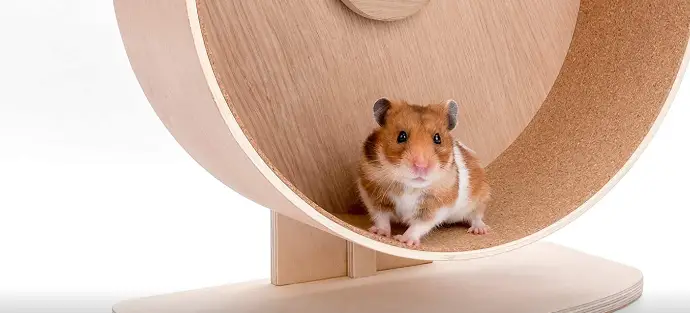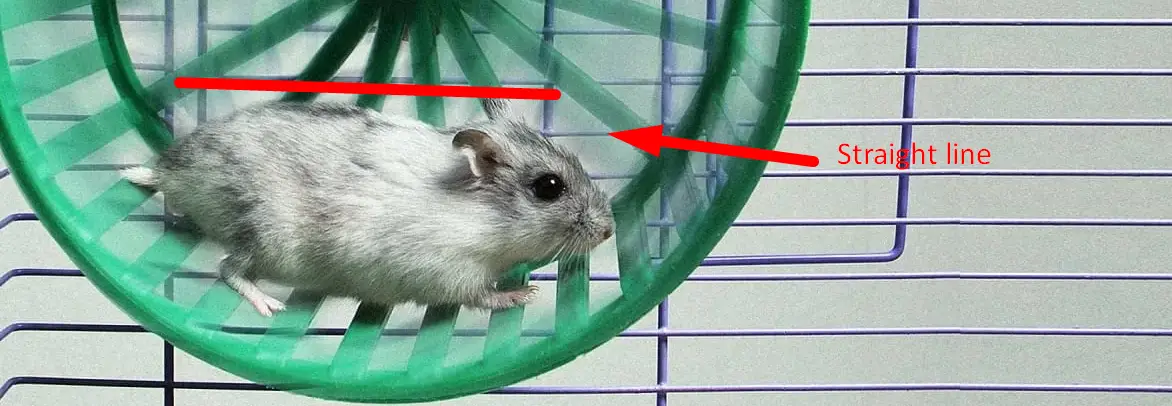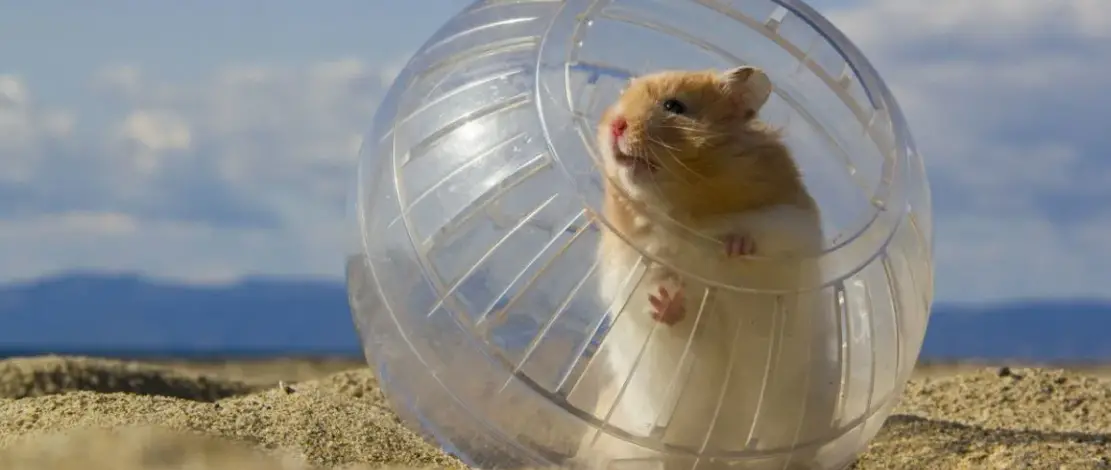Hamsters do need an exercise wheel because it’s the most efficient way to compensate for the lack of activity and space in their small enclosures. The wheel will also help them satisfy their innate need to travel long distances every day and keep them fit and happy.
- Why do hamsters like to run on wheels?
- Do hamsters “Really” need an exercise wheel?
- How long do hamsters need to exercise?
- How To Choose A Suitable Exercise Wheel For Your Hamster?
- When is it better to remove the hamster wheel?
- What happens if my hamster doesn’t use a wheel?
- Hamster wheel “temporary” alternatives
- Reasons why your hamster isn’t using its exercise wheel
- Final Thoughts
- FAQ
Why do hamsters like to run on wheels?
Far from being a stereotypical behavior, running on the wheel is a voluntary behavior in hamsters, and . This means that hamsters have chosen to run on wheels, and it’s not a naturally occurring behavior, even though it’s self-reinforcing and good for them.

Primarily, hamsters run rather than walk to increase their chances of survival outside their burrows, since predators prefer prey that is sick, exhausted, and easy to catch. By running, the hamster lets predators, especially birds of prey and snakes, know that it is healthy and not easy to hunt.
Hamsters are born to run, and they like to run for several reasons. The first is to satisfy their innate need to explore their territory, hoarding food and nesting materials and keeping intruders away.
Running on the wheel is also a voluntary act that satisfies their curiosity, and once the hamster discovers that it can run under cover and without the risk of being attacked by a predator, it becomes addicted to its wheel.
It’s also possible that using the wheel becomes a game for the hamster; it generally feels better after using the wheel than before.
Even though it has been proven that using the wheel does not have a direct effect on the hamster’s weight, it doesn’t change the fact that hamsters have high energy levels, are built to run, and are biologically programmed to be very energetic, to run, to dig their burrows, to hoard. Hamsters are creatures that don’t like to sit still, as evidenced by the fact that as soon as you hold your hamster in your hands, it starts moving, so you let it go!
Running on a wheel is also a behavior that satisfies a motivation such as play, escaping a predator, and avoiding hunger, since running is instinctively associated with hoarding food.
Finally, when a hamster runs on its wheel, it’s also another way of maintaining its self-confidence, reassuring itself that it’s in excellent physical shape, and reassuring itself that it’s capable of escaping a predator or winning a female for mating, or even defending its territory if necessary.
Do hamsters “Really” need an exercise wheel?
Except in certain cases where the hamster is ill, pregnant or too old, it’s certain that it needs its wheel very much, since it has no other alternative to replace it.
Why do hamsters like to run so much? the hamster needs the exercise wheel for different reasons, here are some Benefits of providing your hamster with a good and silent running wheel:
- To satisfy the natural need, scavenger instinct, an urgent and daily need in both Syrian hamsters and dwarf hamsters to run and cover long distances.
- The exercise wheel is a good stress relief for hamsters which helps them avoid many stress-related diseases.
- Hamsters fall ill easily, and the wheel is the best way for them to expend their excess energy and burn off the extra calories they accumulate every day. And it’s been proven that a hamster that uses the wheel often has a better chance of avoiding diseases such as cancer, diabetes, cardiovascular problems, lack of appetite and sleeping disorders.
- Hamsters love to play, but they really don’t have many toys, so the wheel is the hamster’s best toy.
- The wheel is the best way to keep your hamster from becoming obese. Exercise wheel will keep your hamster healthy.
- Exercise wheels are a good source of fun for hamsters, they just like them!
- It was proven that providing a running wheel for your hamster may stop bar-mouthing(bar-mouthing).
- Finally, the wheel is an excellent way to reduce your hamster’s boredom caused by confinement to a small enclosure of a few hundred square inches, whereas hamsters naturally need territories that can extend over several hectares, that’s why they should be kept in big enclosures.
How long do hamsters need to exercise?
Hamsters need at least 2 hours of exercise every day, which is the average time a hamster spends outside its burrow in its natural environment.
And that’s without counting the time and energy spent caring for the burrow and creating new tunnels.
It’s perfectly normal for a hamster to cover a distance of 5.6 Miles (9 km) every day. A healthy hamster could therefore use its wheel for between 4 and 6 hours every day.
Studies have also shown that female hamsters decreased running on the wheel during pregnancy and completely stopped running during the lactation period.
IMPORTANT NOTE:
When you house more than one hamster in the same enclosure ( which is not recommended), make sure that each and every one of them has access to his own exercise wheel.
How To Choose A Suitable Exercise Wheel For Your Hamster?

The first thing to consider when choosing an exercise wheel for your hamster is that it should be as quiet as possible, for three reasons:
1- Your hamster will use it mainly at night, which will avoid noise, especially if the exercise wheel is installed in your bedroom.
2- Some hamsters go to great lengths to avoid making noise (a natural instinct that prevents them from attracting the attention of predators), so they prefer a quiet exercise wheel.
3- Your hamster will prefer a quiet running wheel because it doesn’t offer much resistance and is easier to use, especially if your hamster is weak, sick or just old.
Your hamster wheel must also be well made, stable and not likely to fall off, which could injure your hamster or discourage him from spending as much time as possible on it.
The running surface of a good hamster wheel should be smooth and solid, with no holes. Avoid wheels with wire mesh, which often cause injuries and fractures because your hamster’s paws can easily get caught in the holes. Get a wheel that is made of non-slip materials to prevent your hamster from slipping and falling off.
The ideal size of a hamster wheel
Studies with two wheels (9 in/23 cm and 13 in/35 cm) on Syrian hamsters (especially male hamsters) have shown that hamsters expressed a clear preference for larger wheels, so it’s better to have a larger wheel than a smaller one if you’re not sure what to choose.
Once on the wheel, your hamster’s back should remain straight (not bent forward in an “n” shape or backward in a “u” shape).
It’s often recommended that wheels for Syrian hamsters be at least 10 to 12 inches (25 to 30 cm) in diameter, while the recommended wheel size for dwarf hamsters is at least 6.5 inches (16.5 cm) in diameter.
Finally, you’ll find in this article the wheels I recommend for Dwarf Hamsters and Syrian Hamsters…
What’s the best material for a hamster wheel?

Start by buying a wooden wheel for your hamster. They’re made of natural materials, ideal and practical for both hot and warm weather, they won’t hurt your hamster, and they add to the beauty of your hamster’s enclosure.
But if you find that your hamster has started to chew or relieve himself on its wheel, it’s best to buy him those made of plastic or acrylic, a full, weighted and silent one of course because hamsters are sensitive to noise, they’re also easier to keep clean.
Preferably a wheel with rods, but to ensure good footing on the running surface, but no more than 9 mm between one rod and the other.
Finally, studies of Syrian hamsters have shown that hamsters ran more in wheels with a plastic mesh floor than in wheels with the usual bars. However, since your hamster is likely to get his paws caught in the wheel and injured, it’s important to avoid wheels with a mesh covering and to provide him with a wheel that is simply not slippery.
Where is the best spot for a hamster wheel?
Hamster studies have shown that hamsters prefer wheels at the same level as their nest, and especially at one end of the enclosure, not in the middle of the cage.
How often should I replace my hamster wheel?
A hamster wheel can only be replaced once in its lifetime. You should replace your hamster wheel when it no longer works well or makes too much noise, or when your hamster has grown and needs a larger wheel.
If you change your hamster’s wheel, make sure he’s using it as much as the old one, otherwise find him another wheel that he really likes and will use as much as possible.
When is it better to remove the hamster wheel?
Sometimes it’s better to remove the hamster wheel temporarily. Here are a few rare cases when you should remove it from the cage:
- If your hamster is pregnant (last week of pregnancy)
- If your hamster has babies less than 2 weeks old.
- If your hamster is sick or just starting to recover, especially from a stroke.
- If your hamster has a fracture (wait until it’s completely healed), minor fractures can take between 6 and 8 weeks to heal, while those in places where you can’t bandage them, such as rib fractures, should be removed at around 10 to 12 weeks (replace it with other activities and more food related enrichment and food hidden in the cage to encourage your hamster to stay active).
- If the temperature in the cage rises and you still can’t stabilize it.
What happens if my hamster doesn’t use a wheel?
Will a hamster be okay without a wheel? Sometimes a hamster won’t or can’t use a wheel. Unfortunately, there’s nothing that can effectively replace a hamster’s wheel.
Here’s what a hamster risks when it doesn’t use its wheel and lacks activity:
- Stress and risk of stress-related diseases
- Risk of obesity and related diseases.
- Boredom.
- The wheel can help hamsters warm up in cold weather.
How do you teach your hamster to use the wheel?
Start by choosing the ideal wheel for your hamster, one that’s the right size and made of the right material.
You can then introduce your hamster to the wheel by placing him on it and gently turning him in the right direction.
Alternatively, you can place some seeds and treats on the wheel to encourage your hamster to climb on and discover for himself that he can turn.
It’s worth noting that German researchers conducted an experiment using a wheel in the wild. Wild animals learned to use it on their own, including mice, frogs, and even snails.
So never give up, just keep at it until your hamster finally understands what it’s for, and he’ll soon love it and start using it regularly.
Hamster wheel “temporary” alternatives

Here are some tips on how to “temporarily” replace your hamster’s wheel:
- A larger enclosure to give your hamster more room to explore.
- More objects in the enclosure for your hamster to find things to climb or explore.
- Even if hamsters don’t like it, try to change the location of objects in his enclosure (avoid his pee-spots).
- More bedding to encourage your hamster to stay active by digging new tunnels.
- Get a playpen for your hamster so he has more space to explore.
- Offer him more chew toys to keep him busy, hide food (only dry food, sprays, treats) in the enclosure to create activity.
- If your hamster is used to using a hamster ball, give him one (even if I’m not a fun of hamster balls).
Reasons why your hamster isn’t using its exercise wheel
There are many reasons why a hamster might not use or continue to use its exercise wheel, but here are the most important:
Your hamster has never been introduced to an exercise wheel:
One of the main reasons a hamster completely ignores its wheel is because it doesn’t know what it is! Hamsters can discover the wheel on their own and start using it very quickly, but they are often introduced to it by their mother or another litter mate.
If not, if your hamster used to use the wheel but has suddenly stopped, it’s probably due to one of these reasons:
- Your hamster is ill, has a hidden fracture or injury in one of its legs.
- Your hamster’s diet is too low in calories.
- Your hamster has outgrown the wheel and is experiencing back pain every time he uses it.
- The wheel is not stable or not good, and your hamster has already fallen off the wheel several times.
- The wheel makes too much noise, which can stress your hamster and cause him not to use it.
- It’s too hot for your hamster or too cold in the enclosure and your hamster prefers burrowing or spending more time in its nest than getting out and using its wheel.
- Your hamster is getting too old.
- Your hamster is pregnant or still in lactation.
What other toys do hamsters like?
When you remove your hamster’s wheel for any reason, it’s essential to replace it with other toys to keep your hamster busy and entertained. Here are a few options:
- Tunnels
- Tubes
- Treat balls
- Chew toys
- More boxes
- More hides
- Ladders
- Platforms
Final Thoughts
A hamster needs an exercise wheel and will also enjoy using it, not only for its health benefits, but also to relieve stress, avoid bar biting and aggressive behavior, and provide an excellent way to pass the time and avoid boredom.
The wheel is therefore very important for your hamster. You just have to choose it carefully and change it as soon as your hamster gets bigger, to avoid causing back problems.
FAQ
Do hamsters run on wheels when stressed?
If your question is, is it a sign of stress when a hamster uses its wheel? The answer is no. But if you’re asking if using the wheel helps the hamster relieve stress, the answer is yes, because when a hamster is on its wheel, it’s not stressing out, it’s satisfying an innate need to run, which certainly makes it happy.
How do hamsters know how to run on the wheel?
Most hamsters learn to use the wheel from their mother, litter mates, or cage mates. But a hamster can also learn to use the wheel on its own, and this has been demonstrated by exposing adult hamsters to wheels, and they soon learn to use and love them on their own.
Do hamsters know they are running on a wheel?
Hamsters probably know the difference between running in their cage or playpen and running on a wheel. But we can assume that since the only image your hamster sees when running on its wheel is the rolling surface, it’s possible that it’s thinking about something else at the same time, perhaps imagining that it’s running in wide meadows or on the steppe.
Why do hamsters run on wheels at night?
Hamsters are crepuscular and sometimes nocturnal animals, so all their activities take place after dark. Hamsters therefore use their wheels more often at night, which is consistent with their behavior in their natural environment, where they often spend an average of two hours out at night.
References
How running wheels affect hamsters behavior


